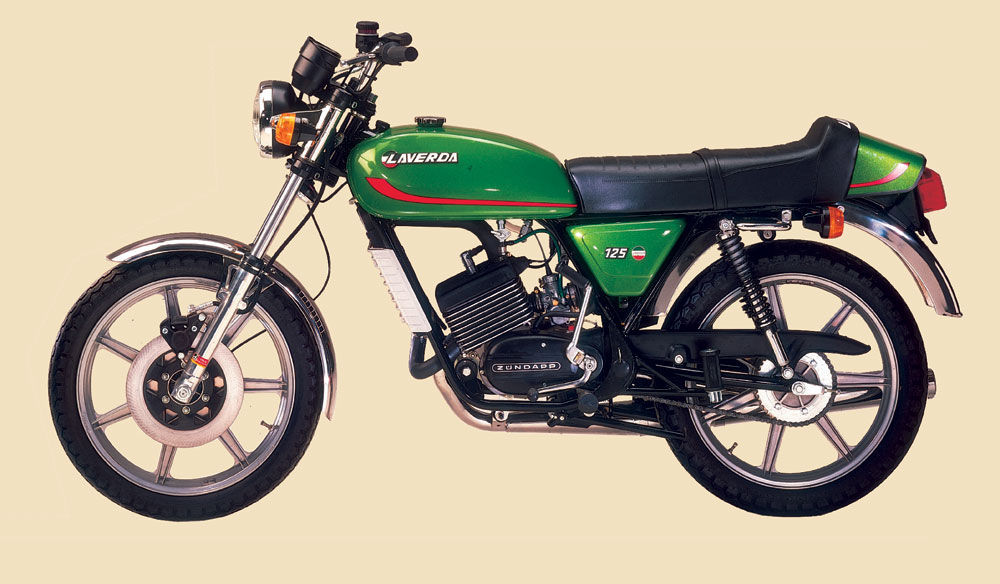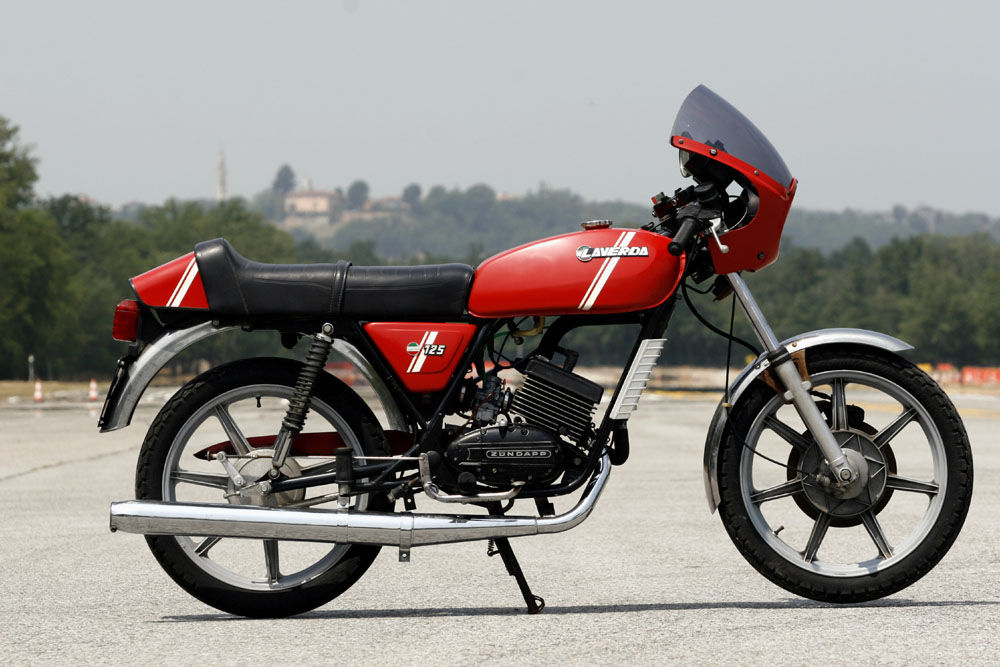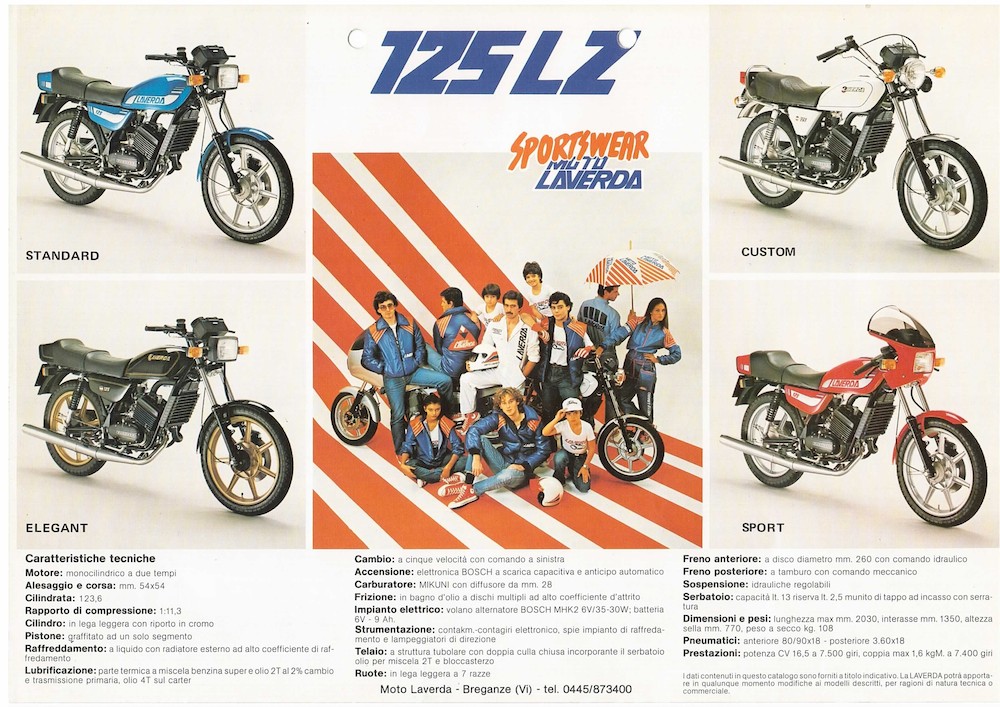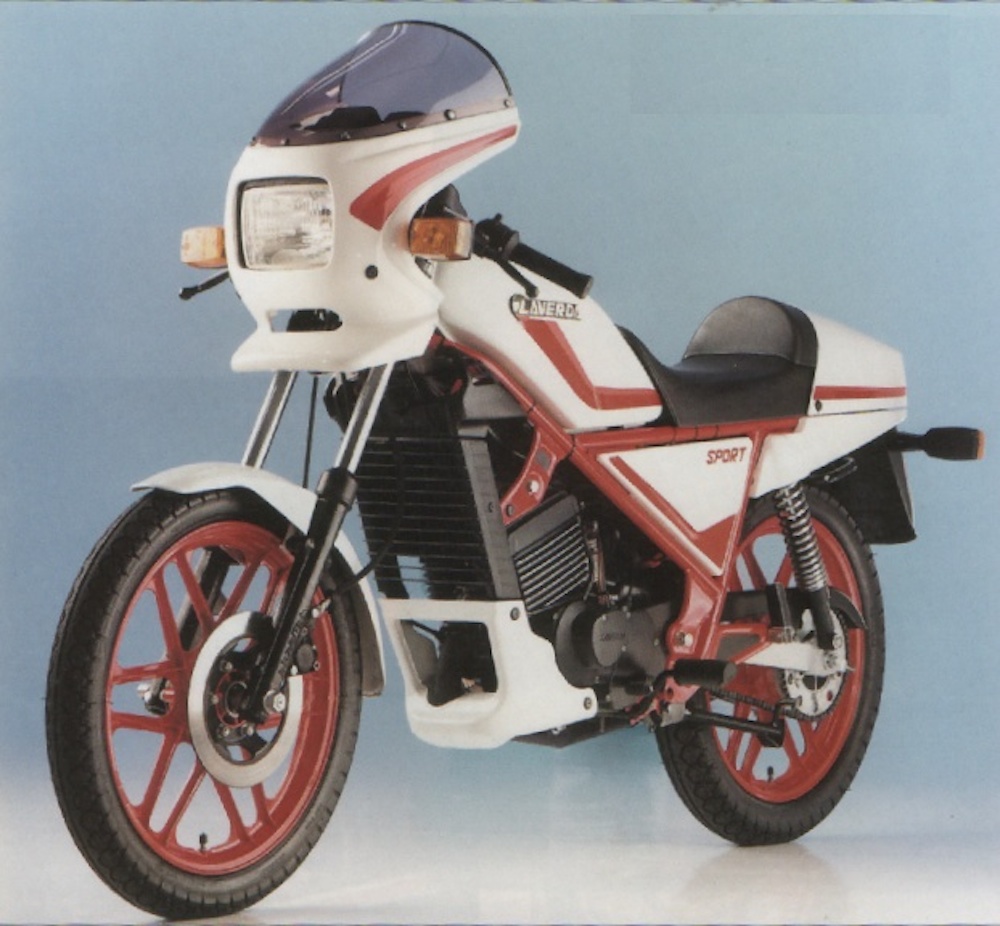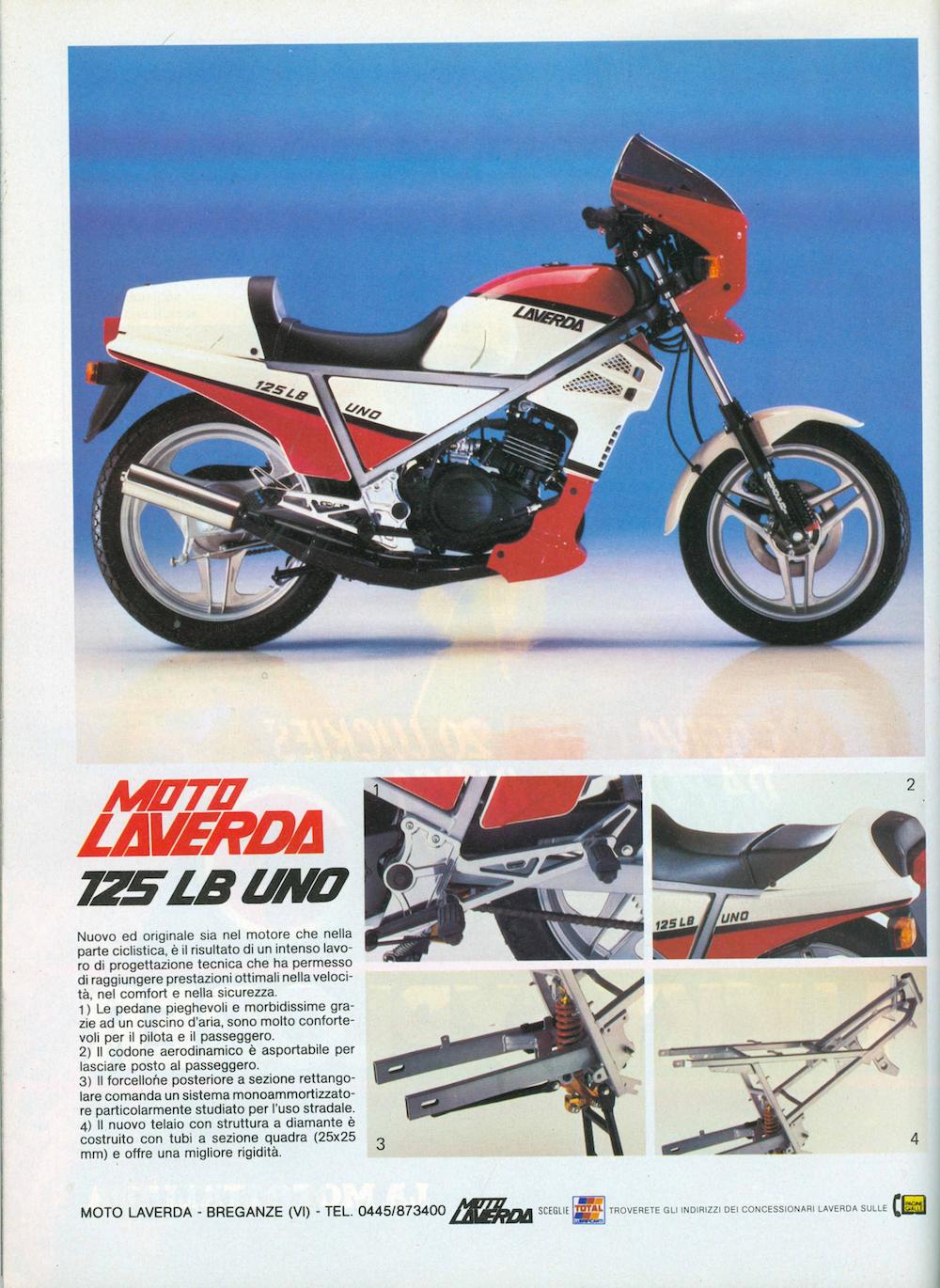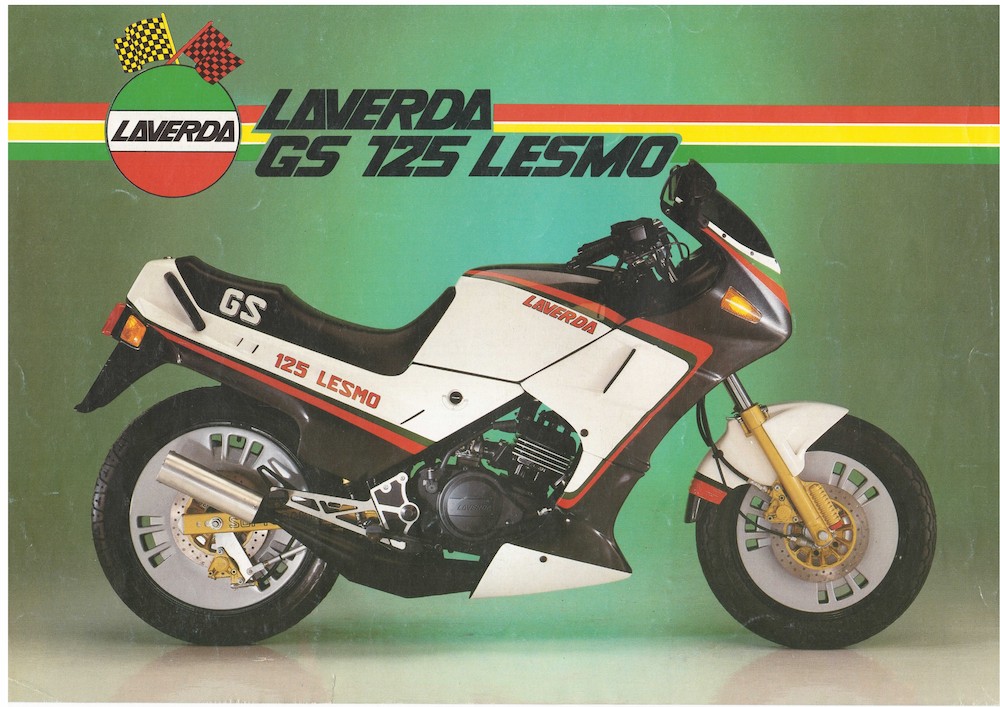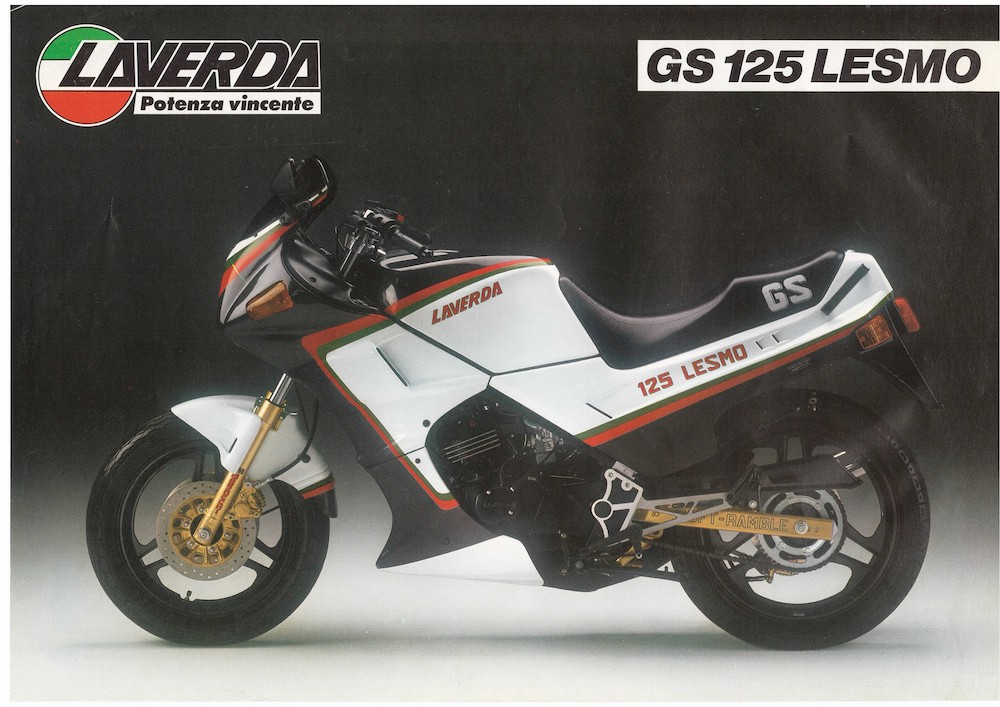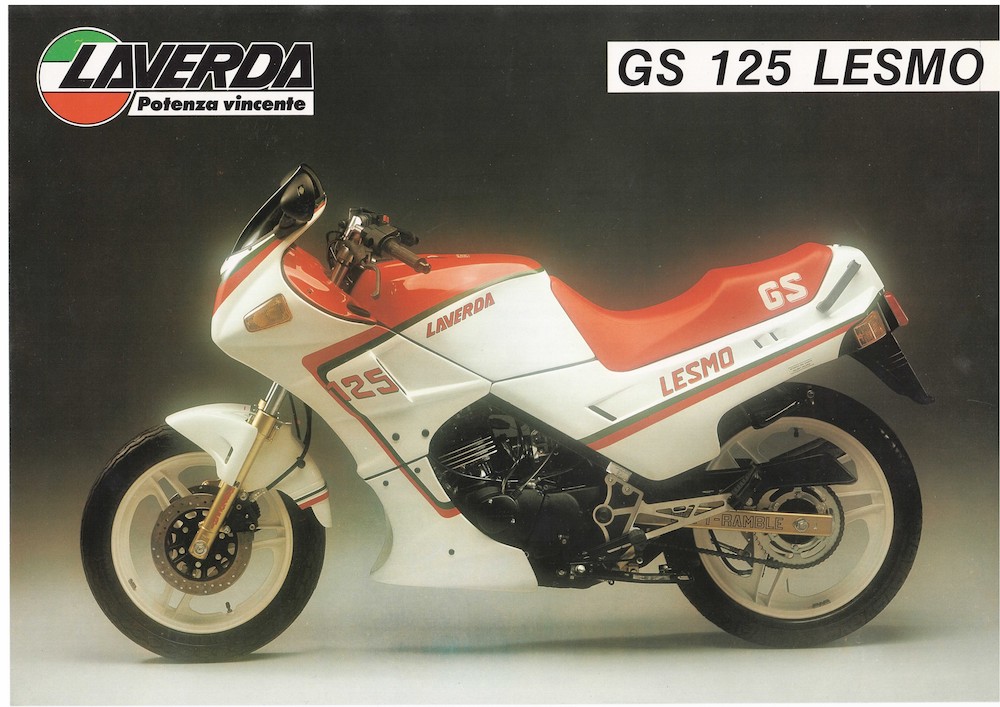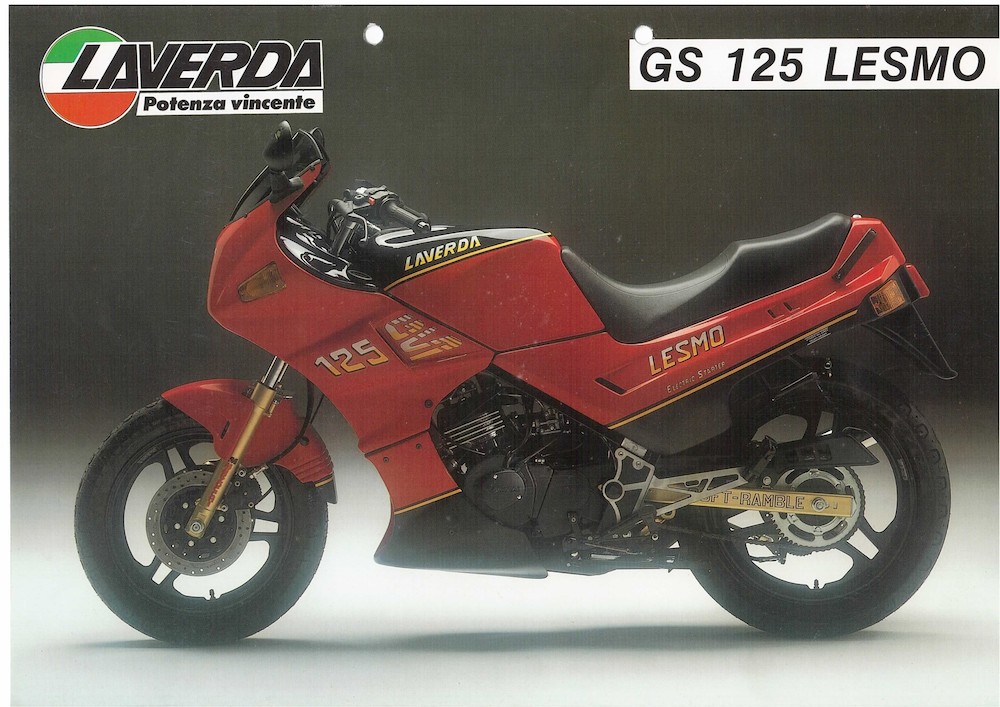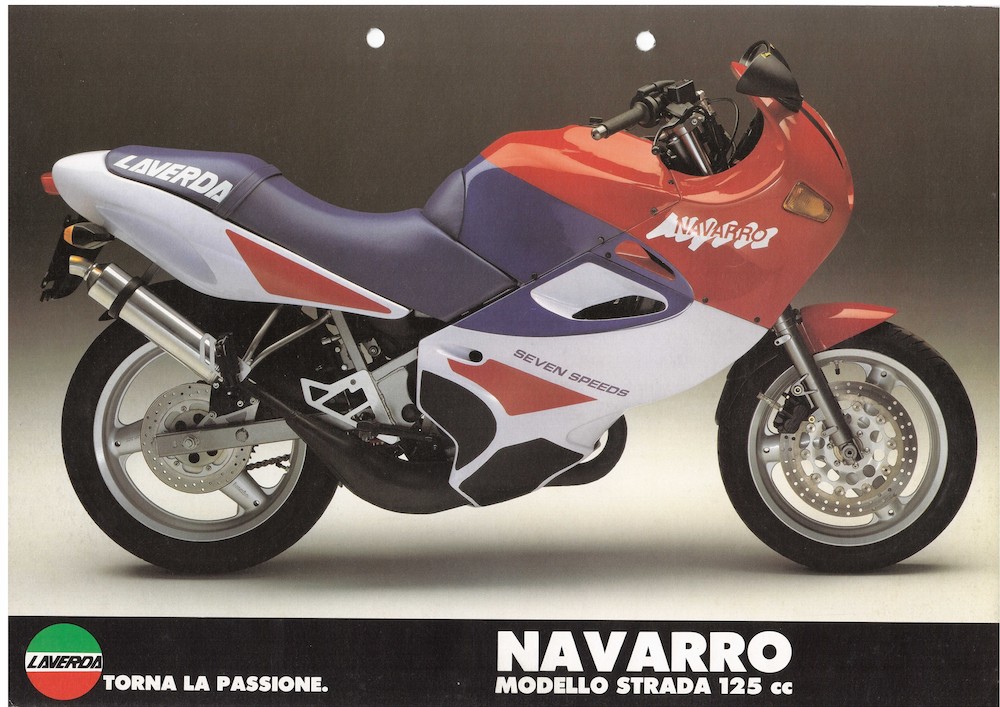Laverda. Un nome che a molti fa ancora battere il cuore e non solo in Italia. Le mitiche SF, SFC e 3 cilindri rimarrano per sempre nel cuore degli appassionati, diventando a loro modo una delle migliori espressioni della scuola motoristica italiana degli anni 70. Laverda è però anche un nome che molti ricorderanno nella classe 125. La serie LZ 125 vendette addirittura 20 mila esemplari e sono molti i motociclisti di oggi che si sono fatti le ossa sulle mitiche LZ. Nel campo delle 125 stradali, Laverda è stata anche antesignana nei trofei monomarca, dove con il suo Trofeo Laverda disputato tra il 1984 ed il 1986 vide le sue LB Sport e Uno regalare tante emozioni a moltissimi giovani che in quegli anni grazie alla casa di Breganze, poterono scegliere di imparare come si guida una moto in pista, confrontandosi tra di loro in sicurezza.
Ecco i modelli prodotti:
LZ 125 – 1977
Presentata al Salone di Milano nel 1977 e commercializzata poco dopo, la Laverda Lz è il frutto della collaborazione tra Laverda e Zundapp – da cui deriva l’acronimo LZ– che coniuga design italiano a motore tedesco.
Verso la fine degli anni 70, Aspes con la Yuma e Malanca con le OB One bicilindriche sono le 125 stradali più prestazionali sul mercato, ma si tratta anche di moto artigianali e decisamente estreme per l’utenza media, che oltre alle prestazioni cerca anche una 125 stradale affidabile e guidabile tutti i giorni. Qualità che Aspes e Malanca certamente non possiedono.
Nel 1977 la moda delle 125 da regolarità comincia a essere sorpassata da quella per i modelli stradali ed i fratelli Laverda, con grande visione imprenditoriale, colgono immediatamente l’attimo. Per la loro 125 stradale, raggiungono, infatti, un accordo con la tedesca Zundapp che produce l’unico 125cc 2 tempi raffreddato a liquido. Un motore che grazie al raffreddamento a liquido (con una semplice circolazione a termosifone) garantisce prestazioni ed affidabilità migliori, consumi ridotti ed esclusività.
La Lz diviene quindi il giusto compromesso tra affidabilità, prestazioni e qualità costruttiva andando quindi a conquistarsi un posto d’onore nel mercato delle 125 stradali. Un successo al quale la Zundapp partecipa direttamente anche con la sua 125 stradale prodotta in Germania: la Ks 125. Lz e Ks condividono quindi una linea simile, dotazioni simili, una ciclistica simile e lo stesso motore che tra le due versioni è esattamente lo stesso. Che cosa cambia allora? L’immagine!
Complice un prezzo di vendita più contenuto rispetto alla Zundapp (1.720.000 lire la Lz Sport del 1981 contro i 2.100.000 Lire della Ks) e la capillare presenza dei concessionari Laverda sul territorio italiano, la Lz ottiene un successo di vendite netto rispetto alla ks. Tuttavia, un prezzo elevato ed una diffusione limitata sono sinonimo di esclusività. Ecco quindi che la Ks diviene la 125 stradale preferita dai giovani benestanti, come i primi “paninari” degli anni Ottanta, che la eleggono a vero e proprio status symbol. Una moda nata a Milano grazie, tra l’altro, alla presenza della ditta Perere che per anni è stata lo storico importatore italiano per Zundapp.
Laverda rimane quindi destinata a un pubblico più vasto ed eterogeneo e con oltre 20.000 esemplari prodotti dal 1977 al 1984, la Lz si impone come una delle 125 stradali più vendute di sempre. Un successo che dura anche dopo la sua uscita di produzione, con una forte richiesta nel mercato dell’usato che continua per anni.
Nel corso delle stagioni vengono modificati diversi dettagli come sella, codino, tappo del serbatoio con chiave, faro quadrato in sostituzione di quello tondo e forcella con predisposizione per il secondo freno a disco anteriore. Si arricchisce anche la gamma colori e si avvicendano diverse versioni: Sport, la più venduta, distinguibile dal cupolino, Elegant, caratterizzata dalla livrea nera con cerchi e finiture dorate, Standard, praticamente una sport senza cupolino e Custom, con forcella più lunga e manubrio alto. La Lz viene prodotta anche in versione per maggiorenni da 175cc, che le è identica per tutto meno che, ovviamente, per la cilindrata.
Fra i difetti che divengono una caratteristica distintiva del modello ricordiamo il silenziatore di scarico molto lungo, con il terminale cromato che oltrepassa la ruota posteriore e che viene regolarmente limato sull’asfalto da chi ama l’impennata facile. Il cambio del motore Zundapp si distingue anche per la difficoltà di inserimento delle marce che richiedono il movimento di tutta la gamba per evitare di incappare in un’impietosa “sfollata” tra un cambio di marcia e l’altro. Sono diversi i sedicenni dell’epoca che per poter guidare “legalmente” la loro Lz in autostrada, sostituiscono i fianchetti con la scritta identificativa del modello da 175cc!
La moto in breve
La linea della Lz è senza dubbio piacevole nelle versioni Sport ed Elegant. Il cupolino dona alla Sport quel tocco di sportività in più, ma anche senza, la Lz ha una bella linea con il faro rotondo e la strumentazione che danno bella mostra di se. Il faro nelle versioni successive diventerà quadrato.
Il serbatoio, i fianchetti ed il codino sono ben disegnati e si accordano bene alla linea della moto e variano nella forma nel corso degli anni.
La strumentazione di produzione Vdo è la stessa montata sulla Zundapp Ks. E’ dotata delle classiche spie di servizio, inclusa l’eccessiva temperatura dell’acqua. Come sulla Ks, la spia del folle non è collegata.
Ciclistica
Il telaio della Lz è un classico monotrave superiore con doppia culla chiusa in tubi di acciaio.
Il reparto sospensioni prevede all’anteriore una forcella non regolabile Marzocchi da 32 mm ed al posteriore due ammortizzatori Sebac regolabili nel precarico molla abbinati ad un forcellone in acciaio.
Il freno anteriore è un Brembo a disco fisso da 260 mm con pinza a monopistoncino, mentre al posteriore viene utilizzato un tamburo da 160 mm. Nel corso degli anni la forcella viene dotata della predisposizione per montare un secondo disco anteriore.
Le ruote in lega hanno 7 razze e sono entrambe da 18”.
Motore
Il propulsore della Lz è esattamente lo stesso montato sulla Zundapp Ks. Caratteristica del propulsore è la presenza del raffreddamento a liquido con circolazione a termosifone, cioè con circolazione naturale priva di pompa ad acqua. Dotato di accensione elettronica e cambio a 5 marce, il propulsore Zundapp è quanto di più raffinato esista su una 125 stradale.
Il gruppo termico mantiene delle alettature di raffreddamento, ma principalmente per una questione estetica. Il carburatore è un valido Mikuni VM 28 servito da un’ampia cassa filtro. Non è presente il miscelatore automatico. L’impianto di scarico è caratterizzato da un terminale piuttosto lungo.
Il motore eroga 18 cv alla ruota al regime di 7500 giri per una velocità massima di 120 km ora.
LB 125 – 1984
Commercializzata a partire dal 1984, la LB, dove Lb significa Laverda Breganze, segue la fortunata serie Lz che viene mantenuta in listino. Come per il precedente modello, Laverda presenta la Lb in diverse versioni: Sport, Strada; Sabbia e Custom.
Il prezzo di vendita nel 1984 è di Lire 2.750.000 e per la versione Sport le colorazioni disponibili sono bianco con inserti rossi, telaio e ruote verniciati di rosso o bianco con inserti blu, telaio e ruote verniciati di blu.
La Lb, specie nella versione Sport dotata di cupolino, è una bella moto, ma tecnicamente è inferiore alla migliore concorrenza che nel mercato delle 125 stradali del 1984 si chiama Aprilia Stx e Gilera Rv. Entrambe adottano, infatti, una componentistica migliore (specie la Rv), una ruota anteriore da 16”, sospensione posteriore con mono ammortizzatore progressivo e motori tecnicamente più avanzati con dotazioni, che nel caso della Rv, comprendono addirittura l’avviamento elettrico.
Le 125 ad alte prestazioni vedono l’affermazione delle velocissime Hrd che diventano le Bimota delle 125 stradali e di Malanca che con la sua Ob One Racing raggiunge l’apice della produzione delle sue potenti bicilindriche. Purtroppo, sono però moto inaffidabili e veramente estreme per l’uso quotidiano.
Tra le 2 tempi raffreddate a liquido, la Lb si trova quindi ad essere una via di mezzo tra le sopra citate 125 stradali e le più semplici Lz, Garelli Tsr e Fantic Strada Sport.
Con la Lb Sport, Laverda inaugura nel 1984 il primo Trofeo Laverda per una 125 stradale. Una bella idea che verrà ripresa anche da Honda, Gilera e successivamente anche da Cagiva.
La moto in breve
Il telaio con struttura a “diamante” domina la linea della Lb e contribuisce a renderla senza dubbio molto originale. Il cupolino con spoiler della versione Sport rende aggressiva la Lb ed ha un look decisamente più sportivo che non il cupolino montato sulla precedete Lz.
Il radiatore ha una griglia di protezione in plastica nera che prosegue con un puntale in tinta con la carrozzeria. Il serbatoio, i fianchetti ed il codino sono ben disegnati e si accordano bene alla linea della moto. La Sport è dotata anche di un copri sellino per il passeggero che la rende molto sportiva e che ricorda la Laverda Rgs.
La strumentazione di produzione giapponese con due strumenti di forma quadrata non ha un look particolarmente attraente. E’ dotata di numerose spie di servizio, ma è comunque inferiore alla migliore concorrenza. I blocchetti elettrici sono dei classici Cev di buona fattura, comuni ad altre 125 stradali del periodo.
Ciclistica
Il telaio della Lb è un’inedita struttura a “diamante” con traliccio superiore tubolare e caratterizzato da una geometria di sterzo differente rispetto al telaio montato sulla precedente Lz.
Il reparto sospensioni prevede all’anteriore una forcella non regolabile Marzocchi da 32 mm ed al posteriore due ammortizzatori Sebac regolabili nel precarico molla abbinati ad un nuovo forcellone a sezione rettangolare in acciaio.
Il freno anteriore è un Brembo a disco fisso da 260 mm con pinza a monopistoncino, mentre al posteriore viene utilizzato un tamburo da 160 mm. Vi è la possibilità di montare un secondo disco anteriore, come per le moto che corrono nel Trofeo Laverda.
Le ruote hanno le seguenti dimensioni: 80/100-16 all’anteriore e 18 al posteriore.
Motore
Il propulsore LB viene profondamente rivisto rispetto all’unità Zundapp montata sulla Lz. I tecnici Laverda modificano il basamento che ora ha i carter di forma diversa (perdendo il caratteristico marchio “Zundapp”) e vengono apportate opportune modifiche alla trasmissione, che mantiene un cambio a 5 rapporti, ed in genere agli ingranaggi interni.
Il gruppo termico rimane il precedente Zundapp montato sulla Lb, ma oltre ad essere rivisto internamente, viene anche arricchito dell’ammissione lamellare diretta nel cilindro. Rimane il raffreddamento a liquido con circolazione a termosifone, cioè con circolazione naturale priva di pompa acqua.
Il carburatore è ora un Dell’Orto PHBH 28 in luogo del precedente Mikuni VM 28 SS che monta la Lz ed è dotato di un miscelatore automatico. L’impianto di scarico è inedito.
LB 125 UNO – 1985
Presentata al Motor Show di Bologna del 1984 e commercializzata a partire dal Gennaio 1985, la LB Uno, dove LB significa Laverda Breganze, è la diretta evoluzione della Lb Sport presentata nel 1984 e aggiornata con un nuovo telaio in tubi quadri, un inedito mono ammortizzatore posteriore e una nuova ruota anteriore da 16”.
Il prezzo nel 1985 è di Lire 3.393.820 ed le colorazioni disponibili sono bianco/rosso e nero/rosso.
Guardando la Lb, gli estimatori della casa di Breganze noteranno una certa somiglianza con l’ammiraglia della casa, cioè la Rgs 1000 tre cilindri. Tuttavia, esattamente come per la Rgs che risente già alla sua presentazione di una linea superata, anche la Lb Uno accusa una linea un po’ datata.
Curiosamente, nonostante l’adozione di una ruota davanti da 16”, la Lb Uno adotta un nuovo telaio con una geometria di sterzo che rimane invariata rispetto alla precedente Lb e che quindi è più adatta per una ruota anteriore da 18”. Il risultato, a detta delle prove dell’epoca, è una moto un po’ nervosa di avantreno nei curvoni veloci e che richiede continui aggiustamenti di traiettoria.
La Lb Uno viene utilizzata per il Trofeo Laverda nelle stagioni 1985 e 1986 che saranno anche le ultime del Trofeo. La Lb Uno viene rimpiazzata nel 1986 dalla più moderna, ma commercialmente parlando sfortunata, Gs Lesmo.
La moto in breve
Eccetto una nuova carenatura per il radiatore e nuovi fianchetti, la linea della Lb Uno rimane piuttosto simile alla precedente Sport. Nel complesso le poche modifiche apportate e le nuove colorazioni adottate rendono la linea della Lb Uno più filante ed agressiva della sua progenitrice, sebbene rimanga quell’aspetto datato che affliggeva anche la Sport.
Il fianchetto sinistro nasconde il regolatore di tensione ed i fusibili, mentre quello destro permette di tenere sott’occhio il livello della batteria e per la cui rimozione è necessario asportare la sella e che tra l’altro da anche accesso alla cassa filtro aria.
Il livello delle rifiniture è solo discreto ed è chiara una certa approssimazione negli assemblaggi e soprattutto nella disposizione confusa dei cavi a ridosso del cannotto di sterzo. Decisamente economici e di stampo ciclomotoristico la strumentazione e l’antiquato antifurto a colonna che necessita di una chiave diversa da quella di accensione. Meglio i comandi elettrici prodotti dalla CEV e comuni ad altre moto del periodo.
Ciclistica
L’inedito telaio della Lb Uno è un culla aperta in tubi quadri in acciaio che riprende il disegno del telaio montato sulla precedente Sport.
Il reparto sospensioni prevede all’anteriore un’ inedita forcella Marzocchi da 32 mm con anti-dive regolabile su tre posizioni ed al posteriore un monoammortizzatore regolabile Sebac nel precarico che lavora con una sospensione a funzionamento progressivo abbinata ad un forcellone in acciaio.
Il freno anteriore è un Brembo a disco fisso da 260 mm con pinza a pistoncino singolo, mentre al posteriore viene utilizzato un tamburo da 160 mm.
Le ruote hanno le seguenti dimensioni: 80/100-16 all’anteriore e 18 al posteriore.
Motore
Il propulsore della Lb Uno viene rivisto rispetto al motore montato sulla precedente Lb Sport, ma continua ad utilizzare lo stesso basamento con cambio a 5 rapporti che deriva ancora dal motore Lz prodotto dalla Zundapp.
La Lb Uno adotta un gruppo termico inedito con canna del cilindro il lega leggera a 4 luci e ammissione lamellare diretta nel cilindro. Viene mantenuto il raffreddamento a liquido con circolazione a termosifone, cioè a circolazione naturale, quindi privo di pompa acqua. La testata viene rivista ed ora il rapporto di compressione è di 14:1
L’impianto di alimentazione prevede un carburatore Dell’Orto PHBH 28 (come per la Lb Sport, ma tarato diversamente). Nuovo l’impianto di scarico con il terminale cromato.
Sebbene fosse un buon motore nei primissimi anni 80 e avesse il pregio di essere l’unico 125 2T raffreddato a liquido, il motore della LB è nel 1985 oramai vetusto e a differenza della concorrenza non solo non è dotato di valvola allo scarico, ma nemmeno del contralbero di equilibratura, dell’avviamento elettrico e della sesta marcia.
L’erogazione della potenza è ad ogni modo buona ed il motore si rivela anche piuttosto elastico. La potenza massima alla ruota rilevata risulta essere di 17.05 cv a 8250 giri e la velocità massima di 129,496 km/h.
GS 125 LESMO – 1986
Presentata al Salone di Milano nel Novembre 1985 e commercializzata a partire dal Marzo 1986, la GS Lesmo è l’evoluzione della precedente LB Uno. Presentata con delle originali ruote lenticolari, che ricordano quelle montate sulle Gilera Kz e Kk, la Lesmo viene poi messa in produzione con delle classiche ruote in lega per ovviare a problemi di omologazione.
La Gs Lesmo si differenzia dalla precedente Lb per la grintosa linea alla moda con dimensioni da maxi moto che porta ad un deciso cambio di rotta rispetto all’impostazione da motoleggera che la Lb aveva ancora in comune con la sua progenitrice Lz.
Il prezzo nel 1986 è di Lire 4.488.000 chiavi in mano ed i colori disponibili sono nero/bianco con profili rosso/verde, sella nera e cerchi neri oppure rosso/nero con profili dorati, sella nera e cerchi neri. Viene poi presentata una terza colorazione bianco/rosso con profili rosso/verde, sella rossa e cerchi bianchi ed in alternativa, nella stessa combinazione di colori, ma con profili rosso/blu.
Nel 1986 la regina delle 125 stradali è la Gilera Kz. La casa di Arcore può anche contare sulla bella e ben rifinita Rv, che rimane in listino. Aprilia propone la As-R che sebbene dal lato estetico sia un mero aggiornamento della precedente Stx, dal lato tecnico vanta un nuovo e potente propulsore Rotax che la rende velocissima. Cagiva presenta la Aletta Oro S2 che riprende le bella linea della precedente S1 con la presenza dell’avviamento elettrico. Honda con la vendutissima Ns-F unisce qualità giapponese a stile italiano. Laverda si propone quindi in un mercato agguerrito e lo fa con una moto troppo costosa rispetto alla concorrenza che tecnicamente le è superiore.
La Gs Lesmo è quindi una bella e ben rifinita 125 stradale, ma le ristrettezze di bilancio (sono infatti anni molto bui per Laverda) impongono ai progettisti Laverda di arrangiarsi come possono per la ciclistica e per il motore che sebbene adotti finalmente la sesta marcia, purtroppo deve rinunciare alla valvola allo scarico e all’avviamento elettrico.
Alla Gs Lesmo seguirà la Gsr che sebbene venga presentata nel 1987, non viene mai messa in produzione. L’erede sarà quindi la Navarro del 1990.
La moto in breve
La linea della GS Lesmo è molto piacevole. Il nuovo imponente cupolino incorpora i lampeggiatori anteriori e supporta gli specchietti e nel complesso offre una buona protezione. Il cupolino è poi un insieme unico con le due piccole carene laterali che lasciano il motore ampiamente in vista. Ben profilato il puntale anteriore che si unisce bene alle due carene laterali.
Il serbatoio (si tratta di un copri serbatorio, essendo il vero serbatorio celato alla vista) forma un insieme unico con la carenatura, la sella ed i fianchetti che vanno a chiudere molto bene la coda unendo in unico insieme il faro ed i lampeggiatori posteriori. Da notare la particolare conformazione della sella e che ha un piano di seduta rialzato per il passeggero al quale sono comunque dedicate due comode maniglie.
Il livello qualitativo è generalmente migliore rispetto alla LB e sono pregevoli certi particolari come i supporti per le pedane in alluminio e la flangia che sostiene la pinza del disco posteriore posizionata sotto al disco stesso che fanno molto racing. Tuttavia, alcuni particolari come il vetusto antifurto a colonna, la verniciatura dorata molto approssimativa usata per le razze dei dischi freno, le pinze ed il forcellone ed un basso livello qualitativo della componentistica utilizzata, non sono all’altezza della migliore concorrenza.
La nuova strumentazione con sfondo bianco fa molto racing ed è sicuramente più moderna di quella che monta la Lb, ma rimane sempre inferiore a quanto oramai offrono anche i migliori cinquantini. Anche i comandi al manubrio hanno un aspetto antiquato e sono sotto tono rispetto alla concorrenza.
Ciclistica
Il telaio della Lesmo rimane lo stesso tubi quadri in acciaio visto sulla Lb Uno sebbene il cannotto di sterzo è allungato verso il basso ed inclinato di mezzo grado in più, l’avancorsa aumenta di 10 mm ed il passo ruote è nettamente più lungo. Il tutto a vantaggio di una maggiore stabilità che era un punto debole della precedente Lb Uno.
Il reparto sospensioni mantiene una esile forcella Marzocchi da 32 mm, ma ora dotata di regolazione anti-dive. Nuovo il forcellone posteriore sempre in acciaio che adotta una sospensione con monoammortizzatore aggiornatato con un leveraggio diverso rispetto alla Lb Uno.
L’impianto frenante si avvale all’anteriore di una nuova coppia di dischi fissi Brembo da 240 mm serviti da pinze a mono-pistoncino ed al posteriore di un disco singolo da 240 mm servito da pinza mono-pistoncino montata sotto al disco stesso.
Le ruote in lega adottano pneumatici Pirelli nelle seguenti misure: 100/90-16 all’anteriore e 110/80-18 al posteriore.
Il peso rilevato è di 135kg.
Motore
Il propulsore della Lesmo purtroppo rimane lo stesso della precedente Lb Uno e quindi privo delle ultime raffinatezze tecniche che la migliore concorrenza possiede. Importanti accessori come la valvola allo scarico, il contralbero di equilibratura e l’avviamento elettrico non sono purtroppo previsti.
Rispetto all’unità montata sulla LB Uno viene adottato un nuovo gruppo termico sembre con induzione lamellare diretta, un inedito impianto di scarico ed una nuova taratatura per il carburatore che rimane il collaudato Dell’Orto PHBH 28. Viene migliorato il sistema di raffreddamento che ora vanta un’ inedita pompa elettrica per la circolazione del liquido di raffreddamento ed il cambio che ora vanta finalmente la 6 marcia.
L’erogazione è certamente più robusta rispetto al motore montato sulla Lb ed anche l’allungo guadagna oltre 1000 giri, ma l’adozione della 6 marcia comporta un peggioramento della manovrabilità del cambio.
La potenza massima alla ruota rilevata risulta essere di 18.63 cv a 9500 giri (17.05 cv a 8250 giri la LB Uno) e la velocità massima 136,520 km/h, molto migliorata rispetto ai 129,496 km/h rilevati dalla LB Uno.
NAVARRO 125 – 1990
Presentata nel 1990, la Navarro 125 viene prodotta dalla “Nuova Moto Laverda”, una cooperativa che a fine anni 80 prende la gestione della azienda breganzese. Laverda entra, infatti, in amministrazione controllata nel 1986 con la famiglia Laverda che purtroppo esce di scena. Segue un passaggio di consegne che vede una finanziaria milanese provare a rilanciare l’azienda, ma il destino non sorride a Laverda e l’iniziativa non prosegue. Verso la fine del 1988, il marchio Laverda viene quindi rilevato da una cooperativa formata da 70 ex dipendenti che cercano di riportare in vita il marchio.
La Cooperativa sigla quindi un accordo commerciale con la Cagiva per la fornitura dei loro motori che sono i seguenti: propulsore C12 R per Navarro 125, propulsore Blues 125 per Toledo 125 ed infine il propulsore da 50cc degli enduro 50 Cocis e K3 per il Gaucho 50. Per la nuova produzione la Cooperativa sceglie quindi dei nomi spagnoleggianti, che secondo loro sono indicati per il rilancio della produzione Laverda. Per completare il lancio della produzione, si impostano anche due nuove bicilindriche da 700cc: l’enduro El Cid (che assomiglia nelle linee alla Navarro e che rimane allo stato di prototipo) e la custom Hidalgo. Putroppo per la Cooperativa, la ripresa è un fallimento completo e la produzione si interrompe poco dopo.
La Navarro viene posta in vendita al prezzo di Lire 5.980.000, un prezzo decisamente alto per una moto che è tecnologicamente obsoleta e che oltre al motore ha anche gran parte della componentistica in comune con la Cagiva Freccia C12R, anch’essa, nel 1990, una 125 ormai vecchia. Oltre che nella livrea bianco/rosso/viola, la Navarro viene commercializzata in una livrea nero/verde.
La Navarro è quindi oggi una 125 stradale apprezzata dai collezionisti per la sua linea originale, frutto del designer francese Jamel Mecheri, e per la sua rarità, visto che all’epoca nessun 16 enne la voleva e gli esemplari venduti non sono più di qualche centinaio.
Un finale poco glorioso per la grande Laverda che con la prima stradale Lz 125 motorizzò mezza Italia.
La moto in breve
A guardare la Navarro, si può comprendere perché allora non sia piaciuta. Troppo originale ed anticonformista. Troppo per il 16 enne tipo che sogna le moto da corsa o le stradali di grande cilindrata. Se è vero che una linea convenzionale a volte può sembrare banale, è altrettatanto vero che una linea troppo anticoformista a volte può essere semplicemente brutta.
Jamel Mecheri ha indubbiamente creato una linea morbida, con un generoso dimensionamento anteriore, una vita stretta ed un piccolo codino. La moto sembra quasi voglia apparire com un culturista, con spalle larghissime e vita stretta. Il cupolino si estende carenando parzialmente i fianchi della moto per poi agganciarsi alle due carene laterali che lasciano intravedere l’espansione. La sella ed il copri serbatoio (che cela il vero serbatoio in materiale plastico) si uniscono alla carena andando a formare una struttura che cela alla vista il telaio. Il codino ha invece dimensioni più minimaliste che appunto contrastano con l’imponente frontale della Navarro. Gli accoppiamenti e la qualità delle plastiche sono di qualità abbastanza buona.
La componentistica è praticamente tutta Cagiva. I blocchetti elettrici, i semi manubri, la piastra superiore della forcella e le frecce. Gli specchietti invece sono dei Vitaloni, gli stessi montati sulla Gilera Mxr. La strumentazione è una Cev studiata apposta per la Navarro, ma sebbene sia completa nella dotazione è di aspetto datato rispetto al look avveniristico che la moto vuol trasmettere.
Ciclistica
Il telaio della Navarro rimane lo stesso tubi quadri in acciaio con struttura a diamante ormai introdotto sulla Lb. Vengono apportate modifiche per alloggiare il nuovo propulsore e rinforzi nella zona di attacco del forcellone.
Il reparto sospensioni vede una nuova forcella Marzocchi da 35 mm ed al posteriore un forcellone in acciaio mono braccio abbianto ad un mono ammortizzatore aggiornato nel leveraggio.
L’impianto frenante è il medesimo della C12R e vede all’anteriore un disco singolo flottante da 298 mm servito da pinza a doppio pistoncino ed al posteriore un disco singolo da 240 mm servito da pinza mono-pistoncino montata sotto al disco stesso.
Le ruote in lega a razze cave sono acnh’esse le stesse a 3 razze della C12R e adottano pneumatici Pirelli nelle seguenti misure: 100/80-16 all’anteriore e 130/70-17 al posteriore.
Il peso rilevato è di 129 kg.
Motore
Il propulsore della Navarro è la medesima unità montata sulla Cagiva C12R e caratterizzato dalla valvola a controllo elettronico CTS e dal cambio a 7 rapporti.
Il gruppo termico rimane il medesimo 60433 (codice stampato sul cilindro) della C12 e così anche l’alimentazione sempre affidata ad un carburatore PHBH da 28 mm. L’impianto di scarico con espansione e finale in alluminio è invece studiata apposta per la Navarro.
La potenza rilevata alla ruota risulta di 29,33 cv a 10500 giri e la velocità massima di 158 km/h, un risultato dato dalla non buona aerodinamica della moto.

